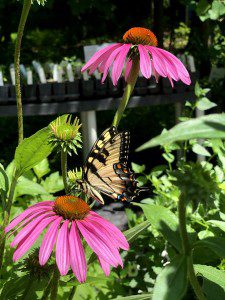I learned all about the benefits of planting native plants when I first started gardening and discovered that I couldn’t keep anything alive. Know the feeling? As it turns out, all it took was a knowledgable and generous friend to lend me some – they actually grew! It was a miracle! And this inspired me to give more thought to my yard and what I could do for it. But where to begin when you’re re-imagining your landscape, by planting more natives that serve more than by just being pretty, when it feels like you’re the only one? How do I even find out what native plants for this area are or where to buy them? Watermark Woods in Hamilton came highly recommended in a local group I’m in, so I took a trip and had a chat with Julie. I am so beyond thrilled she agreed to write for us this week. Hers is truly one of my favorite local businesses; she is so kind and always willing to share her extensive knowledge of all things native plants and butterflies.
Full disclosure: I was guilty of so many of these things. Our entire side yard was covered in english ivy when we bought our home in 2008; just a couple of years ago we ripped it all out and replaced with native wildflowers. It doesn’t take much, just a few plants to get going. Julie has truly changed the way I look at my landscape. The coral honeysuckle she mentions is one of my very favorite plants in my yard.
What are your favorite native plants? Please share with us in the comments. I’m always looking for something new to add to my yard!
Re-imagining the American Landscape
One of my favorite insects is the lightning bug. They always signal summer for me and bring back fond memories of catching them in a mason jar then agonizing over having to release them. Have you noticed that there seem to be fewer lightning bugs these days? Lightning bugs spend the first two years of their life on the forest floor in leaf litter. If we take away the leaf litter and bag it up and send it to the dump or if we take away the forest floor and replace it with housing, what does that mean for the lightning bugs? Or any bugs crucial to our delicate food web?
We ask a lot of our landscaping. We want certain colors, evergreen, well-behaved insect resistant and deer-proof plants. And everything must be separated by a tidy border of mulch. Sadly, when we landscape like this, we forget about the eco-system services our yards can provide. Things like carbon sequestration, run-off control, food for local fauna and water quality mitigation. Our native plants, which evolved here, do a better job at filtering pollutants in our native soil than foreign plants. Plants indigenous to our area provide more nutritious options to our local fauna. While things like Ginko trees provide food for countless organisms in its native territory, here it does not provide for a single species. Changing our view of the function of our landscapes to value diversity and wildlife over aesthetics could be a key to stopping climate change.
We need to re-think how we landscape our yards, open spaces and even our deck or patio. Let our plants wander and flow together creating thick planted areas where mulch is not needed. Say good bye to shrubs that are poisonous to our native birds like Heavenly bamboo (Nandina domestica) and plants that displace our native flora like English ivy (Hedra helix). Instead replace them with Witchalder (Fothergilla gardenia) and Coral honeysuckle (Lonicera sempervirens). Welcome the holes in your leaves because that is a clear signal that you provided a good clean meal for someone. Simply re-thinking how much mulch and what type of mulch we use and consider plants for the value they add to our whole ecosystem and not just please us, lightning bugs (and several million others) will instantly regain their habitat and increase bio-diversity.
Every yard, no matter how small, can have a little bit of wildlife habitat. A shrub or flowers in a pot can be a welcome oasis for a monarch making its migration or a bird looking for a caterpillar who has been munching on those leaves. Native grass seed heads popping up above the winter snow are nature’s winter bird feeders. You can make a difference in any space you have. The plants in our yards are the key to saving the insects, the birds, the amphibians and mammals (humans!).
My wish is that every child can experience something as magical as a lightning bug and understand the importance of having to let it go.
About the author:
Julie is a long time Loudoun resident, mother of 2, wildlife enthusiast and owner of Watermark Woods-Native Plants in Hamilton, VA.
All photos in this post courtesy of Julie.













